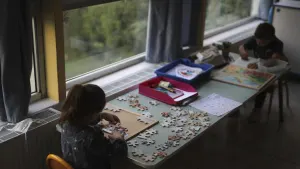More Stories
by Stephanie Rose, News 12
Take a deep breath. Stay calm. Relax. As public officials continue to deliver the news about how our whole world will be turned upside down each day, we simultaneously hear messages to stay calm. But staying calm in the hustle and bustle of normal life is already challenging enough. Let alone in the middle of a global crisis. It's like living in an alternate reality. The mental health impacts of dealing with the coronavirus pandemic are very, very real. There is a pandemic of panic and fear that goes along with all the uncertainty we face. For those who have anxiety, or pre-existing mental health challenges, and even for the most centered among us, our emotional and mental well-being is being pushed to the brink day after day. As a yoga, meditation and breathwork teacher, I want to offer you one technique that can have a positive, balancing effect on the body - to bring a few moments of calm to your mind.
Take a Deep Breath
Take a deep breath to relieve some of the stress and anxiety of dealing with the coronavirus crisis. But how? Deep diaphragmatic breathing can activate the relaxation response in the brain.
Take a deep breath to relieve some of the stress and anxiety of dealing with the coronavirus crisis. But how? Deep diaphragmatic breathing can activate the relaxation response in the brain.
Guide:
1. Sit in a comfortable upright position with the eyes closed, on the floor or even in a chair with the feet flat on the ground.
2. We will be inhaling and exhaling through the nose (you can use your mouth if you are congested or unable to breathe through the nose).
3. When you take a deep breath, focus on the breath in three parts: belly, ribs and collarbone.
4. On the INHALE, expand the belly, followed by ribs, followed by collarbone area.
5. On the EXHALE, allow to fall in the opposite order; collarbone, ribs, then belly.
6. Repeat as many time as needed focusing on expanding on the inhale.
Balancing Breath
Yoga breathing has been shown to be an effective way to stabilize your mood, energy and stress levels. This is a balancing breath practice that you can use any time of day to center yourself amid the chaos of the coronavirus crisis.
Yoga breathing has been shown to be an effective way to stabilize your mood, energy and stress levels. This is a balancing breath practice that you can use any time of day to center yourself amid the chaos of the coronavirus crisis.
Guide:
1. Sit in a comfortable upright position with the eyes closed, on the floor or even in a chair with the feet flat on the ground.
2. We will be inhaling and exhaling through the nose (you can use your mouth if you are congested or unable to breathe through the nose).
3. We will be using a slight constriction of the back of the throat, almost as if you are whispering or fogging up a mirror (see video for how to).
4. INHALE through the nose to a count of 1, 2, 3, 4.
5. EXHALE through the nose to a count of 4, 3, 2, 1.
6. Do this for 10 rounds. Repeat the 10 rounds up to 3 times (for a total of 30 rounds).
1. Sit in a comfortable upright position with the eyes closed, on the floor or even in a chair with the feet flat on the ground.
2. We will be inhaling and exhaling through the nose (you can use your mouth if you are congested or unable to breathe through the nose).
3. We will be using a slight constriction of the back of the throat, almost as if you are whispering or fogging up a mirror (see video for how to).
4. INHALE through the nose to a count of 1, 2, 3, 4.
5. EXHALE through the nose to a count of 4, 3, 2, 1.
6. Do this for 10 rounds. Repeat the 10 rounds up to 3 times (for a total of 30 rounds).
Relaxing Breath
This is a technique used by the U.S. Navy SEALS to help them stay calm in the face of combat. It’s a simple breath practice that uses the concept of a box to help illustrate the pattern of breathing used.
This is a technique used by the U.S. Navy SEALS to help them stay calm in the face of combat. It’s a simple breath practice that uses the concept of a box to help illustrate the pattern of breathing used.
Guide:
1. Sit in a comfortable upright position with the eyes closed, on the floor or even in a chair with the feet flat on the ground.
2. We will be inhaling and exhaling through the nose (you can use your mouth if you are congested or unable to breathe through the nose).
3. INHALE through the nose to a count of 1, 2, 3, 4.
4. HOLD the breath (do not strain) for a count of 1, 2, 3, 4.
5. EXHALE through the nose to a count of 1, 2, 3, 4.
6. HOLD the breath (do not strain) for a count of 1, 2, 3, 4.
7. If you have any trouble holding your breath reduce the count as much as needed going as low as holding for 1 count.
8. Do this for 10 rounds. Repeat the 10 rounds up to 3 times (for a total of 30 rounds).
Sleeping Breath
Trouble sleeping? You’re not alone. The worry we are dealing with as we face the uncertainty of this crisis can really keep us up at night. Try this simple breath practice if you are having trouble sleeping at night, or waking up throughout the night. Using an extended exhalation, this will physically activate the resting response in the body and mind so you can get to sleep.
Trouble sleeping? You’re not alone. The worry we are dealing with as we face the uncertainty of this crisis can really keep us up at night. Try this simple breath practice if you are having trouble sleeping at night, or waking up throughout the night. Using an extended exhalation, this will physically activate the resting response in the body and mind so you can get to sleep.
Guide:
1. Perform this breath practice lying down on a mat or even in bed before sleep with the eyes closed.
2. INHALE through the nose to a count of 1, 2, 3, 4.
3. EXHALE through the nose to a count of 8,7,6,5,4,3,2,1.
4. When you inhale, be sure to fill the lungs so that the 8 count on the exhale can be done.
5. If counting from 8 feels difficult, start with 6 and work your way up
6. Do this for 10-30 rounds or as long as needed until you fall asleep.
2. INHALE through the nose to a count of 1, 2, 3, 4.
3. EXHALE through the nose to a count of 8,7,6,5,4,3,2,1.
4. When you inhale, be sure to fill the lungs so that the 8 count on the exhale can be done.
5. If counting from 8 feels difficult, start with 6 and work your way up
6. Do this for 10-30 rounds or as long as needed until you fall asleep.
More on breathing techniques
Controlled breathing techniques have been extensively studied as a tool to help ease anxiety.
On the physical level, consciously controlling your breathing can induce the relaxation response in the brain by modulating your central nervous system.
For the mind, focusing on your breath can divert your attention away from your thoughts giving you a much needed mental break.
To understand the basic physiological response in the body, I want you to think of yourself as a walking, talking nervous system. The central nervous system controls the automatic functions of the body that you don't think about on a day-to-day basis; like digestion, circulation, and breathing. It is generally active in one of two states - the fight or flight (sympathetic nervous system response) or the rest and digest (parasympathetic nervous system response). Can you guess what state the coronavirus pandemic has put us in? The fight or flight, nearly all day, every day. When we are constantly active in the fight or flight state, we can feel stressed, tense and overwhelmed. The palms sweat, the heart rate increases, and digestion shuts down as the body prepares to fight for survival. We evolved this way to preserve human life in the face of predators during early human history. But now we perceive an invisible predator that is putting us in this stressed-out state constantly, the virus.
The good news? When we consciously control the breath it has been shown to activate the rest and digest response and turn off this fight or flight state. Deep, conscious breathing can dial back our anxiety by slowing the heart rate, inducing calm and allowing the mind to come to rest. “Take a deep breath” is actually useful advice. But knowing how to take a deep breath properly, is the key to getting the body and mind to relax.
Watch my videos to learn more about how you can breathe to relieve the stress of this all, even if just for a few minutes.
For more tips, follow me at @stephanierosetv on Instagram.
More from News 12
1:48

Mobile vaccine van parks at Brooklyn Borough Hall
0:23

New Excelsior Pass Plus app extends beyond New York jurisdiction

Your Coronavirus 2020 Photos

10 online learning tools for students to use at home
11:21:40

6 tips for home schooling children and remote learning
